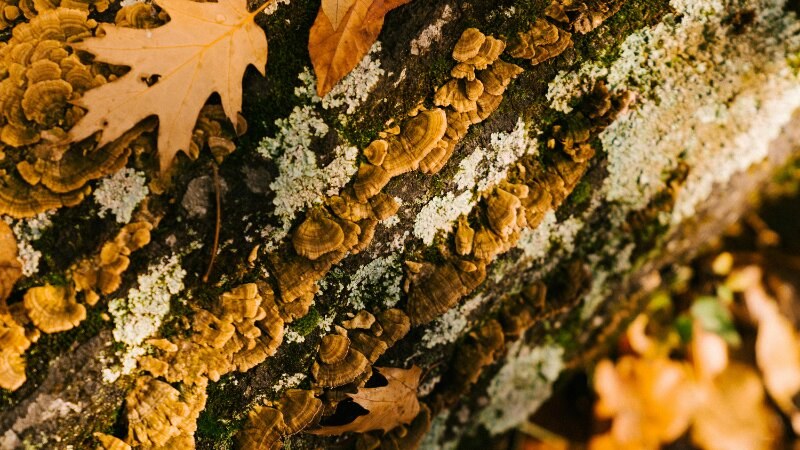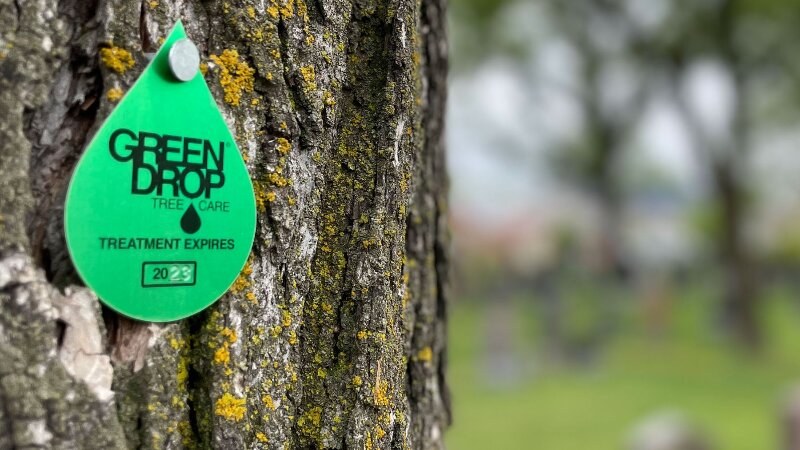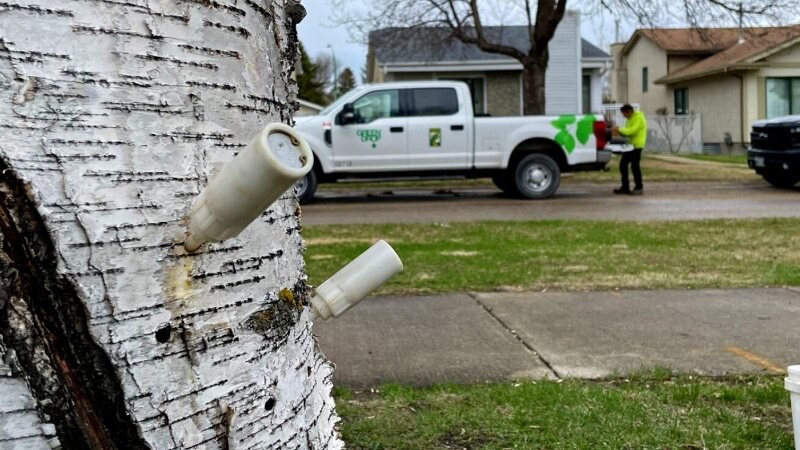Most Common Tree Diseases in Saskatoon and How to Stop Them
Reading time: 6 minutesWhile common throughout Western Canada, tree diseases can be severe and threaten the life of your trees. It's a good idea to have a basic understanding of tree health problems you're likely to encounter and what you should do if it happens.
We'll go over six crucial tree diseases, how to prevent and manage them on your Saskatoon property, and how our ISA-certified arborists can help.

Dutch Elm Disease
In recent years, the City of Saskatoon has reported multiple cases of Dutch Elm Disease (DED), which is a serious tree health problem that deserves more widespread attention. Dutch elm disease affects mostly elm trees, but can sometimes infect non-elm tree varieties.
This disease is caused by a fungus spread by infected elm bark beetles. The fungus starts to destroy the tree's ability to absorb water from the inside out. The bark of a tree with DED usually has unmistakable "spider-like" formations in the wood.
The condition is stealthy, spreading throughout a tree's internal vascular system, where it causes significant damage before developing any outward signs of the condition. Wood from infected trees generally can't be reused, especially as firewood, since this promotes the spread of the disease to surrounding healthy trees when transported from one place to another.
Signs of Dutch Elm Disease
Some of the signs of DED to stay on the lookout for include:
- The foliage on one or more tree branches suddenly droops, curls, or wilts
- Tree leaves turn brown or yellow prematurely but don't fall off the tree
- You can see red or brown streaks in the wood underneath the tree's outer bark
Saskatoon has a robust response plan to control DED within the city, which includes taking multiple samples, removing positive trees, properly disposing of infected trees, and inspecting the area for other potential sources of the disease.
Green Drop will work directly with the city to ensure all testing and removal requirements are met, so you can relax knowing everything's being taken care of for you by the book.
Galls
Galls are irregular growths on tree branches, twigs, and sometimes leaves. They can vary in size, shape, and structure, but generally always present as abnormal, tumor-like growths. While most galls aren't serious in and of themselves, they can be an indicator of the bacteria, viruses, fungi, or parasites that caused them. If one or more of your trees have galls, it's a good idea to have them checked for other problems like wasp infestations or mite infections.
Managing galls can be done by applying horticultural oil during the winter when trees are dormant, using insecticidal soap, or pruning the galls away with clean tools. Which method is used is determined by the type of galls you have, their size, and other factors.
Fireblight
Fireblight is a highly contagious tree disease that mostly affects certain types of fruit trees and some plants within the rose family, including apple, pear, and crabapple trees. This condition is caused exclusively by the Erwinia amylovora bacteria, which is winter hardy and spreads rapidly throughout a tree's vascular system in the spring and summer.
Signs a tree is infected with fireblight include:
- Discolored or weeping cankers on a tree's bark
- Leaves, twigs, and small branches that look shriveled or burned
- Waterlogged, red-hued lesions on the outer bark
- Blossoms that wilt and die when they should be blooming
- Dead-looking leaves that never fall
Fireblight can be managed by pruning blighted areas away in the winter with disinfected tools to avoid spreading the Erwinia bacteria. While no cure for fireblight exists, some chemical sprays, antibiotics, and bactericides can be used preventatively to protect trees from developing the condition.
Canker Diseases

Cankers are sections of a tree that are dead, which usually appear on the bark of a tree's trunk and branches. This happens most often when the external bark of a tree is injured, which creates favorable conditions for pests to nest and pathogens to replicate. Cankers may not kill a tree outright, but they can give way to other conditions that will, like wood-rotting bacteria, decay, fungi, and insects.
Like with other tree diseases, preventing cankers is generally more effective than trying to get rid of them once a tree has already become infected. However, even the best efforts can be foiled by conditions out of your control. By keeping your trees healthy, you increase their resistance to cankers and canker-causing microorganisms. In cases where management isn't an option, trees with cankers may need to be removed and replanted with resistant varieties.
Leaf Spot
The term "leaf spot" refers to a group of tree diseases typically—although not always—caused by fungi. The most obvious symptom of this condition is discolored spots on the leaves of an affected tree, but afflicted trees may also exhibit other symptoms, including dieback and leaf drop.
Common types of fungal leaf spot diseases include:
- Anthracnose
- Black spot
- Frogeye leaf spot
- Tar spot
- Macrophoma leaf spot
- Bacterial leaf spot
- Cercospora leaf spot
Most of the time, leaf spot diseases won't cause serious harm to your trees, but they can impact the look and aesthetics of your home and yard. To manage leaf spot, keep trees well-pruned to ensure proper light penetration and air circulation throughout your tree's canopy.
Antifungals and bactericides may be helpful prevention strategies but may not be advisable if a tree is already infected. Trees with leaf spot should also not be fertilised until the condition is under control.
Saskatoon Juniper Rust
Saskatoon juniper rust is a fungal disease that requires two separate host plants to flourish. First, galls develop on the stems of juniper or cedar shrubs. When these are soaked with rain, they produce tendrils that release spores into the air that are then carried to certain fruit trees, including hawthorn, apple, and Saskatoon trees.
At this time, the infection presents as orange or yellow "rust" on the leaves of an affected tree. Spots can usually be found on the underside of Saskatoon leaves and the top of hawthorn and apple tree leaves.
Unfortunately, few, if any, treatments exist for infected trees, and they generally need to be removed to avoid spreading spores to another host. Prevention strategies also include pruning away any galls or swollen areas found on the branches and bark of juniper or cedar trees. Acting quickly is of the utmost importance with this complex tree disease.

ISA-Certified Arborists Are Here to Help
We have a team of tree arborists who understand trees and can meet all your tree risk assessment, tree inspection, and tree care service needs. We provide comprehensive tree health care services in Saskatoon.
If you suspect a tree on your property has become infected with Dutch Elm Disease, leaf spot, fireblight, or another tree disease, don't hesitate to reach out to our team to get in touch with a tree specialist who can help. Schedule your free tree care assessment and get an estimate.
We also serve Winnipeg, Regina, Calgary, Edmonton, and Red Deer.

